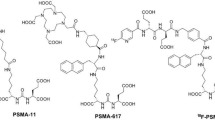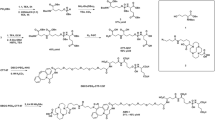Abstract
Non-invasive detection of prostate cancer or metastases still remains a challenge in the field of molecular imaging. In our recent work of screening arginine- or lysine-rich peptides for intracellular delivery of a therapeutic agent into prostate cancer cells, an arginine-rich cell permeable peptide (NH2GR11) was found with an unexpectedly preferential uptake in prostate cancer cell lines. The goal of this work was to develop this peptide as a positron emission tomography (PET) imaging probe for specific detection of distant prostate cancer metastases. The optimal length of arginine-rich peptides was evaluated by the cell uptake efficiency of three fluorescein isothiocyanate (FITC)-tagged oligoarginines (NHGR9, NHGR11, and NHGR13) in four human prostate cell lines (LNCaP, PZ-HPV-7, DU145, and PC3). Of the three oligoarginines, NH2GR11 showed the highest cell uptake and internalization efficiency with its subcellular localization in cytosol. The biodistribution of FITC-NHGR9, FITC-NHGR11, and FITC-NHGR13 performed in control nude mice displayed the unique preferential accumulation of FITC-NHGR11 in the prostate tissue. Further in vivo evaluation of FITC-NHGR11 in PC3 tumor-bearing nude mice revealed elevated uptake of this peptide in tumors as compared to other organs. In vivo pharmacokinetics evaluated with 64Cu-labeled NH2GR11 showed that the peptide was rapidly cleared from the blood (t 1/2 = 10.7 min) and its elimination half-life was 17.2 h. The PET imaging specificity of 64Cu-labled NH2GR11 was demonstrated for the detection of prostate cancer in a comparative imaging experiment using two different human cancer xenograft models.




Similar content being viewed by others
References
Albrecht S, Buchegger F, Soloviev D, Zaidi H, Vees H, Khan HG, Keller A, Bischof Delaloye A, Ratib O, Miralbell R (2007) (11)C-acetate PET in the early evaluation of prostate cancer recurrence. Eur J Nucl Med Mol Imaging 34(2):185–196
Alexander CM, Reichsman F, Hinkes MT, Lincecum J, Becker KA, Cumberledge S, Bernfield M (2000) Syndecan-1 is required for Wnt-1-induced mammary tumorigenesis in mice. Nat Genet 25(3):329–332
Beheshti M, Langsteger W, Fogelman I (2009) Prostate cancer: role of SPECT and PET in imaging bone metastases. Semin Nucl Med 39(6):396–407
Boswell CA, Sun XK, Niu WJ, Weisman GR, Wong EH, Rheingold AL, Anderson CJ (2004) Comparative in vivo stability of copper-64-labeled cross-bridged and conventional tetraazamacrocyclic complexes. J Med Chem 47(6):1465–1474
Bouchelouche K, Capala J, Oehr P (2009) Positron emission tomography/computed tomography and radioimmunotherapy of prostate cancer. Curr Opin Oncol 21(5):469–474
Bucci M, Gratton JP, Rudic RD, Acevedo L, Roviezzo F, Cirino G, Sessa WC (2000) In vivo delivery of the caveolin-1 scaffolding domain inhibits nitric oxide synthesis and reduces inflammation. Nat Med 6(12):1362–1367
Chen D, Adenekan B, Chen L, Vaughan ED, Gerald W, Feng Z, Knudsen BS (2004a) Syndecan-1 expression in locally invasive and metastatic prostate cancer. Urology 63(2):402–407
Chen XY, Park R, Hou YP, Tohme M, Shahinian AH, Bading JR, Conti PS (2004b) MicroPET and autoradiographic imaging of GRP receptor expression with Cu-64-DOTA-[Lys(3)]bombesin in human prostate adenocarcinoma xenografts. J Nucl Med 45(8):1390–1397
Datta MW, Hernandez AM, Schlicht MJ, Kahler AJ, DeGueme AM, Dhir R, Shah RB, Farach-Carson C, Barrett A, Datta S (2006) Perlecan, a candidate gene for the CAPB locus, regulates prostate cancer cell growth via the Sonic Hedgehog pathway. Mol Cancer 5:9
Elson-Schwab L, Garner OB, Schuksz M, Crawford BE, Esko JD, Tor Y (2007) Guanidinylated neomycin delivers large, bioactive cargo into cells through a heparan sulfate-dependent pathway. J Biol Chem 282(18):13585–13591
Emonds KM, Swinnen JV, Mortelmans L, Mottaghy FM (2009) Molecular imaging of prostate cancer. Methods 48(2):193–199
Etchebehere ECSC, Macapinlac HA, Gonen M, Humm J, Yeung HWD, Akhurst T, Scher HI, Larson SM (2002) Qualitative and quantitative comparison between images obtained with filtered back projection and iterative reconstruction in prostate cancer lesions on F-18-FDG PET. Q J Nucl Med 46(2):122–130
Fogelman I, Cook G, Israel O, Van der Wall H (2005) Positron emission tomography and bone metastases. Semin Nucl Med 35(2):135–142
Gambhir SS (2002) Molecular imaging of cancer with positron emission tomography. Nat Rev Cancer 2(9):683–693
Giovacchini G, Gajate AM, Messa C, Fazio F (2008) Increased C-11 choline uptake in pagetic bone in a patient with coexisting skeletal metastases from prostate cancer. Clin Nucl Med 33(11):797–798
Gratton JP, Yu J, Griffith JW, Babbitt RW, Scotland RS, Hickey R, Giordano FJ, Sessa WC (2003) Cell-permeable peptides improve cellular uptake and therapeutic gene delivery of replication-deficient viruses in cells and in vivo. Nat Med 9(3):357–362
Hara T, Kosaka N, Kishi H (1998) PET imaging of prostate cancer using carbon-11-choline. J Nucl Med 39(6):990–995
Kirn-Safran C, Farach-Carson MC, Carson DD (2009) Multifunctionality of extracellular and cell surface heparan sulfate proteoglycans. Cell Mol Life Sci 66(21):3421–3434
Langsteger W, Heinisch M, Fogelman I (2006) The role of fluorodeoxyglucose, 18F-dihydroxyphenylalanine, 18F-choline, and 18F-fluoride in bone imaging with emphasis on prostate and breast. Semin Nucl Med 36(1):73–92
Larson SM, Morris M, Gunther I, Beattie B, Humm JL, Akhurst TA, Finn RD, Erdi Y, Pentlow K, Dyke J, Squire O, Bornmann W, McCarthy T, Welch M, Scher H (2004) Tumor localization of 16beta-18F-fluoro-5alpha-dihydrotestosterone versus 18F-FDG in patients with progressive, metastatic prostate cancer. J Nucl Med 45(3):366–373
Maeda T, Tateishi U, Komiyama M, Fujimoto H, Watanabe S, Terauchi T, Moriyama N, Arai Y, Sugimura K, Kakizoe T (2006) Distant metastasis of prostate cancer: early detection of recurrent tumor with dual-phase carbon-11 choline positron emission tomography/computed tomography in two cases. Jpn J Clin Oncol 36(9):598–601
Nackaerts K, Verbeken E, Deneffe G, Vanderschueren B, Demedts M, David G (1997) Heparan sulfate proteoglycan expression in human lung-cancer cells. Int J Cancer 74(3):335–345
Nakase I, Takeuchi T, Tanaka G, Futaki S (2008) Methodological and cellular aspects that govern the internalization mechanisms of arginine-rich cell-penetrating peptides. Adv Drug Deliver Rev 60(4–5):598–607
Oyama N, Miller TR, Dehdashti F, Kibel AS, Michalski JM, Fischer KC, Picus J, Siegel BA, Andriole GL, Welch MJ (2002) Carbon-11-acetate PET imaging of recurrent prostate cancer. J Urol 167(4):173–174
Oyama N, Ponde DE, Dence C, Kim J, Tai YC, Welch MJ (2004) Monitoring of therapy in androgen-dependent prostate tumor model by measuring tumor proliferation. J Nucl Med 45(3):519–525
Ponde DE, Dence CS, Oyama N, Kim J, Tai YC, Laforest R, Siegel BA, Welch MJ (2007) 18F-fluoroacetate: a potential acetate analog for prostate tumor imaging—in vivo evaluation of 18F-fluoroacetate versus 11C-acetate. J Nucl Med 48(3):420–428
Rogers BE, Bigott HM, McCarthy DW, Della Manna D, Kim J, Sharp TL, Welch MJ (2003) MicroPET imaging of a gastrin-releasing peptide receptor-positive tumor in a mouse model of human prostate cancer using a 64Cu-labeled bombesin analogue. Bioconjug Chem 14(4):756–763
Rothbard JB, Jessop TC, Lewis RS, Murray BA, Wender PA (2004) Role of membrane potential and hydrogen bonding in the mechanism of translocation of guanidinium-rich peptides into cells. J Am Chem Soc 126(31):9506–9507
Sakai N, Takeuchi T, Futaki S, Matile S (2005) Direct observation of anion-mediated translocation of fluorescent oligoarginine carriers into and across bulk liquid and anionic bilayer membranes. ChemBioChem 6(1):114–122
Sanderson RD, Yang Y, Suva LJ, Kelly T (2004) Heparan sulfate proteoglycans and heparanase-partners in osteolytic tumor growth and metastasis. Matrix Biol 23(6):341–352
Sasisekharan R, Shriver Z, Venkataraman G, Narayanasami U (2002) Roles of heparan-sulphate glycosaminoglycans in cancer. Nat Rev Cancer 2(7):521–528
Schuhmacher J, Zhang H, Doll J, Macke HR, Matys R, Hauser H, Henze M, Haberkorn U, Eisenhut M (2005) GRP receptor-targeted PET of a rat pancreas carcinoma xenograft in nude mice with a 68 Ga-labeled bombesin(6–14) analog. J Nucl Med 46(4):691–699
Shreve PD, Grossman HB, Gross MD, Wahl RL (1996) Metastatic prostate cancer: initial findings of PET with 2-deoxy-2-[F-18]fluoro-d-glucose. Radiology 199(3):751–756
Sun XK, Wuest M, Weisman GR, Wong EH, Reed DP, Boswell CA, Motekaitis R, Martell AE, Welch MJ, Anderson CJ (2002) Radiolabeling and in vivo behavior of copper-64-labeled cross-bridged cyclam ligands. J Med Chem 45(2):469–477
Vees H, Buchegger F, Albrecht S, Khan H, Husarik D, Zaidi H, Soloviev D, Hany TF, Miralbell R (2007) F-18-choline and/or C-11-acetate positron emission tomography: detection of residual or progressive subclinical disease at very low prostate-specific antigen values (<1 ng/mL) after radical prostatectomy. BJU Int 99(6):1415–1420
Yang YS, Zhang XZ, Xiong ZM, Chen XY (2006) Comparative in vitro and in vivo evaluation of two Cu-64-labeled bombesin analogs in a mouse model of human prostate adenocarcinoma. Nucl Med Biol 33(3):371–380
Zhang X, Cai W, Cao F, Schreibmann E, Wu Y, Wu JC, Xing L, Chen X (2006) 18F-labeled bombesin analogs for targeting GRP receptor-expressing prostate cancer. J Nucl Med 47(3):492–501
Zhou J, Fan J, Hsieh JT (2006) Inhibition of mitogen-elicited signal transduction and growth in prostate cancer with a small peptide derived from the functional domain of DOC-2/DAB2 delivered by a unique vehicle. Cancer Res 66(18):8954–8958
Acknowledgments
This work was partially supported by the Prostate Cancer Research Program of the United States Army Medical Research and Materiel Command (W81XWH-08-1-0305 and W81XWH-04-1-0222), a Clinical Innovator Award from the Flight Attendant Medical Research Institute, and a small animal imaging research program grant (SAIRP) from the National Institute of Cancer (U24 CA126608). The authors acknowledge the generous support of a private donor that allowed the purchase of the Siemens Inveon PET-CT Multi-modality System.
Author information
Authors and Affiliations
Corresponding authors
Rights and permissions
About this article
Cite this article
Hao, G., Zhou, J., Guo, Y. et al. A cell permeable peptide analog as a potential-specific PET imaging probe for prostate cancer detection. Amino Acids 41, 1093–1101 (2011). https://doi.org/10.1007/s00726-010-0515-5
Received:
Accepted:
Published:
Issue Date:
DOI: https://doi.org/10.1007/s00726-010-0515-5




